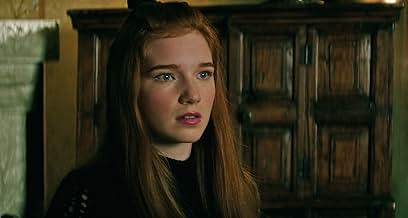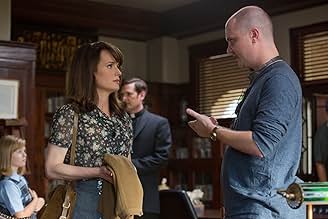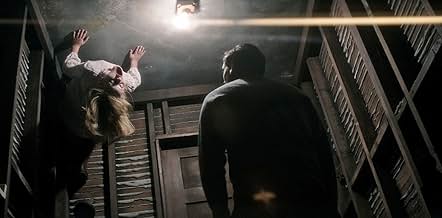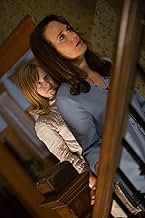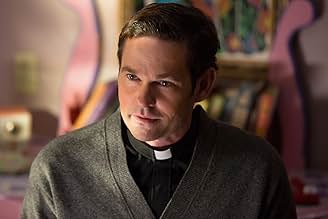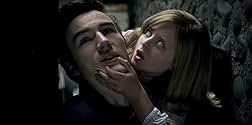Los Angeles, 1967. Una madre vedova e le figlie introducono un nuovo espediente per potenziare la propria attività di frodi spiritiche invitando una presenza malvagia in casa loro, senza ren... Leggi tuttoLos Angeles, 1967. Una madre vedova e le figlie introducono un nuovo espediente per potenziare la propria attività di frodi spiritiche invitando una presenza malvagia in casa loro, senza rendersi conto di quanto sia pericolosa.Los Angeles, 1967. Una madre vedova e le figlie introducono un nuovo espediente per potenziare la propria attività di frodi spiritiche invitando una presenza malvagia in casa loro, senza rendersi conto di quanto sia pericolosa.
- Regia
- Sceneggiatura
- Star
- Premi
- 2 vittorie e 7 candidature totali
Recensioni in evidenza
The film was in better hands when it was announced that Mike Flanagan would be directing but I was still mixed. Oculus was actually pretty great. A creative idea that was actually pretty emotional and investing. Flanagan's followup was the Netflix film Hush. I know a lot of people loved Hush but maybe these people don't watch movies often or are lenient to what they see on Netflix. Hush was terrible. I don't want to go into it here but maybe some other time I can explain how improbably dumb it really is. Anyways, this film is a prequel of sorts to the first and is based on a family who help people move on from their passed loved ones by staging seances. A ouija board causes dark spirits in the house to possess a young girl leading to trouble and at times, some wicked fun.
The film is set in the 60s and you can immediately tell by the film style. The style is of a film you'd see from that era; they even used the old Universal Pictures logo at the start of the film. Its not just the post production editing of the film but the costume, music, and just all around aura is done very well. No one knows her well yet but Lulu Wilson made this film. She does a great job and there are a few moments (where the script was fantastic) and she was able to come off as unsettling, just from saying her lines. She is without a doubt the strongest point of the film.
The film isn't without flaws. The third act isn't exactly fantastic as some questionable things happen and you scratch your head wondering if there could have been a better resolution. There definitely could have been. Also, the CG does look ropy at times but I think that can be forgettable as the film offers decent entertainment value. Here's a film that sacrifices scares for build up, good performances, and focus on the story of why spirits have possessed Doris and the circumstances surrounding whats going on. I can respect that.
I'm usually extremely critical of horror films because these days so many films go for jump scares and have no substance. There are exceptions that are becoming smart, nostalgic, or reinventing the horror genre. I don't think there is anything innovative about Ouija: Origin of Evil but its a massive improvement over its predecessor and is a film has a good amount going for it to make for a good time.
7/10
First off, the scenes were beautiful. It was like watching a warm sunset. In addition, the direction and camera angles really enhanced the suspense and intensity. The special effects were also top notch and at one point I was like, "Whaaaat? That is cool".
I was pretty captivated throughout, although it did have it's clunky moments but not too many of them and they quickly worked their way out of them.
The cast did a superb job with the young Lulu Wilson pretty much stealing the show. I'll most likely be seeing her again in my nightmares. Annalise Basso, Elizabeth Reaser and Henry Thomas also did an excellent job so I don't want to sell them short either.
Overall this was a pleasant surprise with moments of nail-biting suspense. Definitely worth the watch on a dark and quiet night. Oh, and one other reviewer mentioned not watching the preview. I didn't so that might have helped.
This is a film that shouldn't exist, should never have gotten theatrical distribution and definitely shouldn't have attracted the likes of Flanagan (okay, he probably did this to increase his clout in the industry, but still). He musters some great work here, following familiar supernatural clichés but bringing his own touch to the proceedings.
The setting is beautiful, the characters likable and not completely square. The atmosphere is given time to build, he luxuriates in teasing and messing with audience expectations (as a way of spiting this, and goosing the audience lulled into a slow burn placation, he includes an explosive scene wherein the actual demon is seen shoving his fist down the little girl's throat. It's both too much and a necessary jolt at the time, a conundrum if ever there was one and a small encapsulation of everything right and wrong within this film).
It's too bad some of the nice work done in the first 2/3rds of the film is undone by a clichéd, boring, exorcism-lite finale. None of it is very scary, and it all has the feel of fitting into the "Ouija" franchise package, whatever in God's name that could mean. Considering the stakes here, what Flanagan does is still impressive.
It's obvious that Mike Flannigan is on his way to becoming one of our true masters of horror, but this film seems more like a paycheck movie for him and it shows. He does the best he can with the tepid material, but ends up using the old "distorted faces/mouths with rolled back eyes" effect a few too many times and it quickly becomes tedious.
Like all of Flannigan's films, it's wonderfully well cast and beautifully put together. I just wish they'd spent a little bit more time with the script. You might be better off watching Flannigan's Hush, Absentia, Gerald's Game, Occulus, or The Haunting of Hill House.
In the 1960's, widow Alice Zander (Elizabeth Reaser) works as a fortune teller out of her home, staging false séances with the help of her teenage daughter Paulina (Annalise Basso) and younger child Doris. (Lulu Wilson) After purchasing a Ouija board as a new gimmick for her work, Alice does not notice that Doris has become overtaken by a deranged and mysterious force associated with the board, instead believing that her young daughter's newfound abilities and knowledge of things she could not possibly know are signs that unlike her, Doris is a real medium. However, as Doris' abilities become gradually all the more powerful and sinister, Alice and Paulina must band together to try and break her free from the devious spirits of the past that have taken ahold of her physical form...
Flanagan directs from a script co-written by Jeff Howard, and much like his wonderful previous efforts "Oculus" and "Hush", here he continues to shine as one of the finest new voices in horror. There's a certain sense of taste and thoughtfulness he injects into his work, as he takes his time to try and establish strong character and interpersonal relationships, in addition to identifiable human drama which helps to accentuate the fear that builds. He also just knows how to deliver a darned good scare- a skill he uses expertly throughout the entire runtime here to build a great sense of foreboding dread.
The performances are all stellar as well, helping to add to the film's high quality and impact. Elizabeth Reaser is fantastic as the mother Alice, and you really get a feel for a person lost after the death of their beloved spouse who is trying to hold it together for the sake of her children. Wilson is a great new Doris and does remarkably well for an actress of such a young age. Supporting roles by the likes of Henry Thomas are all uniformly strong and help to round out the cast in likable performances. And Annalise Basso steals the show as Paulina (also known as "Lina"), who becomes our main focus and is a strong presence on-screen. At only 17 years old, Basso is definitely one to keep an eye on in the future. She possesses talent far beyond her years, and is the beating heart of the film as a sister and daughter struggling to help her sibling and mother from the forces at play- both supernatural and emotional.
The film does falter at times a bit, which is where it loses points. Despite the first film being decidedly very poor by comparison, this film does a bit of distracting ret-con work that may bother those who are familiar with the original. Some major details of the backstory and rules are changed, which made it feel a bit inorganic as a continuation. It's also a bit too heavy on the scares up- front, which lessened their impact. I would have preferred more slow a buildup. And it does lack some drama since this is a prequel and you'll be able to guess some of what happens based on this fact.
Still, that cannot stop this from being a darned good and very well- assembled supernatural horror. It's not one of the best horror films ever made by any means, but it's a solid and highly entertaining thriller boasting some heart, some good scares and a great cast. This is the movie you've been waiting for if you've wanted to see a movie based around the idea of the dreaded Ouija board. My advice? Skip out on the first film and just watch this as a stand-alone. It's far more rewarding an experience than the awful original could ever hope to be.
I give "Ouija: Origin of Evil" a strong 8 out of 10. If you're open minded, be sure to give it a shot, especially if the last one let you down. Take it from me... this is a very pleasant surprise.
Lo sapevi?
- QuizThe film was shot digitally, but director and editor Mike Flanagan, in order to add a retro feel to the film, added elements in post-production to give the appearance of a movie shot on film. Those include the 'cigarette burns', marks that appear every 20 minutes or so in the upper right corner of the frame, which were used to signal a change of reels for film projected.
- BlooperIn order to make the film appear more authentic for the time in which it is set (1967), cue marks, or "reel change" marks, are inserted at approximately every 20 minutes. However, the marks are oval when they should actually be circular, since this is a film presented in a 1.85:1 aspect ratio and not in a 2.39:1 aspect ratio. The only time the marks should be oval is if a film is projected with an anamorphic lens. On an anamorphic film print, the cue marks are circular, but the anamorphic lens makes the circle look like an oval when projected on a screen.
- Citazioni
Doris Zander: Wanna hear something cool?
Mikey: Sure.
Doris Zander: Do you know what it feels like to be strangled to death? First, you feel the pressure in your throat. Your eyes water, and you start to taste something very, very sour in your mouth. Then it's like someone lights a match right in the middle of your chest, and that fire grows. It fills your lungs, and your throat, and all the way behind your eyes. And finally, that fire turns to ice; like pins and needles of ice are sticking into your fingers, your toes, your arms. You see stars, then darkness. And the last thing you feel... is cold.
[Mikey looks confused and horrified]
Doris Zander: [smiles] Goodnight, Romeo.
- Curiosità sui creditiThere is a post-credits scene with Lin Shaye.
- Colonne sonoreYou Gotta Move Me
Written by Dennis Michael Lacey
Performed by Mike Lacey
Courtesy of Crucial Music Corporation
I più visti
- How long is Ouija: Origin of Evil?Powered by Alexa
Dettagli
- Data di uscita
- Paese di origine
- Siti ufficiali
- Lingue
- Celebre anche come
- Ouija: el origen del mal
- Luoghi delle riprese
- Clark Residences - 306 Loma Drive, Los Angeles, California, Stati Uniti(the girl's school)
- Aziende produttrici
- Vedi altri crediti dell’azienda su IMDbPro
Botteghino
- Budget
- 9.000.000 USD (previsto)
- Lordo Stati Uniti e Canada
- 35.144.505 USD
- Fine settimana di apertura Stati Uniti e Canada
- 14.065.500 USD
- 23 ott 2016
- Lordo in tutto il mondo
- 81.705.746 USD
- Tempo di esecuzione
- 1h 39min(99 min)
- Colore
- Mix di suoni
- Proporzioni
- 1.85 : 1







